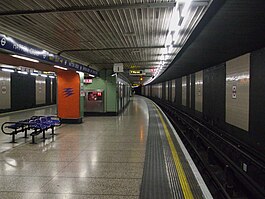
The Piccadilly line is a deep-level London Underground line running from the north to the west of London. It has two branches, which split at Acton Town, and serves 53 stations. The line serves Heathrow Airport, and some of its stations are near tourist attractions such as Piccadilly Circus and Buckingham Palace. The District and Metropolitan lines share some sections of track with the Piccadilly line. Printed in dark blue on the Tube map, it is the sixth-busiest line on the Underground network, with nearly 218 million passenger journeys in 2019.

The London Borough of Hounslow is a London borough in west London, England, forming part of Outer London. It is governed by Hounslow London Borough Council.

Acton Town is a London Underground station in the south-west corner of Acton, West London, in the London Borough of Ealing, close to the border with the London Borough of Hounslow. The station is served by the District and Piccadilly lines and is in Travelcard Zone 3. On the District line, it is between Chiswick Park and Ealing Common stations, and on the Piccadilly line it is between Hammersmith and Ealing Common on the Uxbridge branch & South Ealing on the Heathrow branch. Acton Town station was opened as Mill Hill Park on 1 July 1879 by the District Railway. It remained as a terminus until on 1 May 1883 and 23 June 1903 the DR opened two branches from Acton Town to Hounslow Town and Park Royal & Twyford Abbey respectively. On 4 July 1932 the Piccadilly line was extended to Acton Town. District line services to both the Hounslow and Uxbridge branches were withdrawn completely on 9 and 10 October 1964 after which operations were provided by the Piccadilly line alone.

South Kensington is a London Underground station in the district of South Kensington, south west London. It is served by the District, Circle and Piccadilly lines. On the District and Circle lines it is between Gloucester Road and Sloane Square, and on the Piccadilly line between Gloucester Road and Knightsbridge. It is in Travelcard Zone 1. The main station entrance is located at the junction of Old Brompton Road (A3218), Thurloe Place, Harrington Road, Onslow Place and Pelham Street. Subsidiary entrances are located in Exhibition Road giving access by pedestrian tunnel to the Natural History, Science and Victoria and Albert Museums. Also close by are the Royal Albert Hall, Imperial College London, the Royal College of Music, the London branch of the Goethe-Institut and the Ismaili Centre.

Barons Court is a London Underground station in West Kensington in the London Borough of Hammersmith and Fulham, Greater London. This station serves the District line and the Piccadilly line. Barons Court is between West Kensington and Hammersmith on the District line, and between Earl's Court and Hammersmith on the Piccadilly line and is in Travelcard Zone 2. East of the station, the Piccadilly line descends into tunnel towards Earl's Court and the District line continues in a cutting to West Kensington. The station is the last open air stop for eastbound trains on the Piccadilly line until Arnos Grove and has cross-platform interchange with the District line.

Heathrow Terminals 2 & 3 is a London Underground station at Heathrow Airport on the Heathrow branch of the Piccadilly line, which serves Heathrow Terminal 2 and Terminal 3. The station also served Heathrow Terminal 1 until its closure in January 2016. The station is situated in Travelcard Zone 6, along with the nearby Heathrow Terminals 2 & 3 railway station served by Heathrow Express and Elizabeth line services.

Heathrow Terminal 4 is a London Underground station at Heathrow Airport on the Heathrow branch of the Piccadilly line. The station is situated in Travelcard Zone 6.

Hounslow West is a London Underground station in locality of Hounslow West in Hounslow within the London Borough of Hounslow, West London. The station is on the Heathrow Terminals 2 & 3 branch of the Piccadilly line, between Hatton Cross and Hounslow Central stations and is in Travelcard Zone 5. The station is located on Bath Road, close to the Great West Road (A4). The station has an island platform, with step-free access via a stairlift for manual wheelchair users only.

Boston Manor is a London Underground station at the boundary of the boroughs of Hounslow and Ealing. The station is situated on the Heathrow branch of the Piccadilly line, between Osterley and Northfields stations, in Travelcard Zone 4.
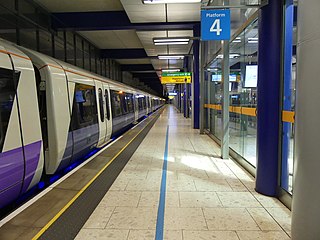
Heathrow Terminal 5 is a shared railway and London Underground station serving Heathrow Terminal 5. It serves as a terminus for Heathrow Express services to Paddington, and for Elizabeth line and London Underground Piccadilly line services to central London. It is managed and staffed by Heathrow Express.
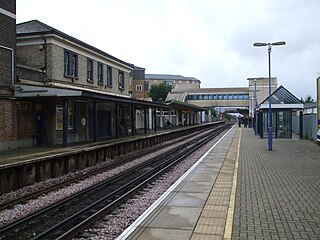
Feltham railway station serves Feltham in the London Borough of Hounslow, west London. It was opened on 22 August 1848 by the Windsor, Staines and South Western Railway.

Hayes & Harlington is a railway station serving the west London districts Hayes and Harlington in the London Borough of Hillingdon. It is 10 miles 71 chains down the line from London Paddington and is situated between Southall and West Drayton.

Stamford Brook is a London Underground station on the eastern edge of Chiswick in west London. The station is served by the District line and is between Ravenscourt Park and Turnham Green stations. The main entrance is located on Goldhawk Road (A402) with a secondary entrance on Prebend Gardens. It is in Travelcard Zone 2.
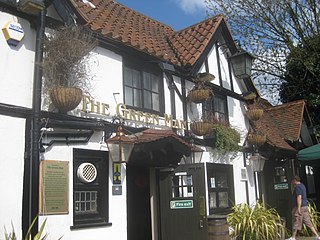
Hatton including Hatton Cross is a small settlement and locality in the London boroughs of Hillingdon and Hounslow, on the south-eastern edge of London Heathrow Airport and straddling the A30 road. Prior to 1965 it was in the county of Middlesex.

Heathrow Terminals 2 & 3 railway station serves Terminal 2 and Terminal 3 at London Heathrow Airport.
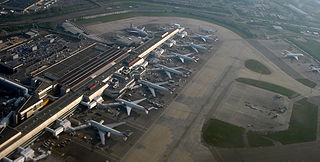
Heathrow Terminal 4 is an airport terminal at Heathrow Airport, the main airport serving London, England, situated to the south of the southern runway, next to the cargo terminal. It is connected to Heathrow Terminals 2 and 3 by the vehicular Heathrow Cargo Tunnel, and by rail with the Heathrow Terminal 4 tube and Heathrow Terminal 4 railway stations. Built at a cost of £200 million, Terminal 4 was opened by the Prince and Princess of Wales on 1 April 1986. British Airways was the main airline operating from the terminal from 1986 until its move to Terminal 5 on 29 October 2009, eventually making Terminal 4 the Heathrow base for airlines of the SkyTeam airline alliance.

Heathrow Terminal 3 is an airport terminal at Heathrow Airport, serving London, the capital city of the United Kingdom. Terminal 3 is currently used as one of the main global hubs of the International Airlines Group members British Airways and Iberia since 12 July 2022. It is also used by the majority of members of the Oneworld and a few SkyTeam alliances along with several long-haul non-affiliated airlines. It is also the base for Virgin Atlantic.
In its early years what is now Heathrow Airport was the Great West Aerodrome, sometimes known as Heathrow Aerodrome.

The history of the District line started in 1864 when the Metropolitan District Railway was created to create an underground 'inner circle' connecting London's railway termini. The first part of the line opened using Metropolitan Railway gas-lit wooden carriages hauled by steam locomotives. The District introduced its own trains in 1871 and was soon extended westwards through Earl's Court to Fulham, Richmond, Ealing and Hounslow. After completing the 'inner circle' and reaching Whitechapel in 1884, it was extended to Upminster in East London in 1902. To finance electrification at the beginning of the 20th century, American financier Charles Yerkes took it over and made it part of his Underground Electric Railways Company of London (UERL) group. Electric propulsion was introduced in 1905, and by the end of the year electric multiple units operated all of the services.
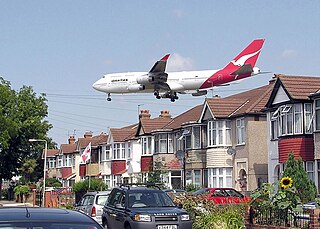
Myrtle Avenue is a street in the London Borough of Hounslow which is near the eastern end of Heathrow Airport's south runway, 27L. This makes it noisy when aircraft are landing or taking off from 27L, or taking off from 9R, though its view of the aircraft has made it the prime location for plane spotting.
